When you start building your back muscles, words like “renegade rows” and “good mornings” might sound complicated.
As a beginner, you might not know the names of many back exercises. Finding new exercises or understanding workouts can be hard if you don’t understand the terms.
Don’t worry! This blog post will clearly overview 100 standard back exercises for beginners, using easy-to-understand names and descriptions.
Our extensive back exercise glossary provides clear images and simple details to help you understand back anatomy and proper form.
You will learn about common equipment to train back, such as barbells, dumbbells, resistance bands, and bodyweight.
We will cover all major back muscle groups, including the lats, traps, rear delts, rhomboids, and more.
You must Bookmark this reference guide.

- Barbell Back Exercises Names
- 1. Deadlift
- 2. Bent Over Barbell Rows
- 3. Landmine Row
- 4. Standing Barbell Rear Delt Row
- 5. Barbell Upright Row
- 6. Barbell Chest Supported Row
- 7. Barbell Shrug
- 8. Barbell, Good Morning
- 9. Landmine Deadlift
- 10. Seal Row (Flat Bench Row)
- 11. Barbell Pullover
- 12. Meadows Row
- 13. Barbell Hip Bridge
- 14. Clean And Jerk
- 15. Pendlay Row
- 16. Rack Pull
- 17. Romanian Deadlift
- 18. Sumo Deadlift
- 19. Barbell High Pull
- 20. Snatch Grip Deadlift
- Dumbbell Back Exercises Names
- 1. One-Arm Dumbbell Row
- 2. Dumbbell Deadlift
- 3. Dumbbell Shrug
- 4. Dumbbell Upright Row
- 5. Dumbbell Bent Over Row
- 6. Incline Dumbbell Row
- 7. Renegade Row
- 8. Dumbbell Farmers Walk
- 9. Side-Lying Rear Fly
- 10. Bent Over Rear Delt Fly
- 11. Dumbbell Pullover
- 12. Dumbbell Seal Row
- 13. Dumbbell Good Mornings
- 14. Dumbbell Superman
- 15. Dumbbell Wood Chopper
- 16. Dumbbell Glute Bridge
- 17. Dumbbell Swings
- 18. Chest-Supported Rear Delt Row
- 19. Dumbbell Gorilla Row
- 20. Dumbbell Romanian Deadlift
- 21. Dumbbell I, Y, T, W Raise
- Name Of Cable Back Exercises
- 1. Lat Pulldown
- 2. One-Arm Lat Pulldown
- 3. Seated Cable Rows
- 4. Wide Grip Seated Row
- 5. Straight Arm Lat Pulldown
- 6. V Bar Lat Pulldown
- 7. Incline Straight Arm Pulldown
- 8. Cable Twisting Standing Row
- 9. Seated One Arm Cable Row
- 10. Double Cable Neutral-Grip Lat Pulldown
- 11. Straight Arm Rope Pulldown
- 12. Bent Over One Arm Cable Pull
- 13. Cable Upright Row
- 14. Cable Shrug
- 15. Cable Pullovers
- 16. Cable High Row
- 17. Reverse Cable Crossover
- 18. Face Pull
- 19. Low Cable Row
- 20. Cable Deadlift
- 21. Close Grip Lat Pulldown
- 22. Reverse Grip Lat Pulldown
- 24. Behind-The-Neck Lat Pulldown
- 25. Cable Machine Y Raise
- 26. Bent Over Cable Lateral Raise
- 27. Cable Rear Delt Row
- 28. Cable Stiff-Leg Deadlift
- GYM Machine Back Exercises With Names
- 1. Chest Supported Row
- 2. Landmine Row
- 3. Pec Deck Machine (Reverse Fly)
- 4. Iso-Lateral Lat Pulldown
- 5. Back Extension Machine
- 6. Assisted Pull-Up Machine
- 7. Rowing Machine
- 8. Smith Machine For Back Workout
- 9. Seated Back Extension
- 10. Smith Machine Stiff-Legged Deadlift
- 11. Smith Hip Thrust
- 12. Chest Supported Row
- Name Of Bodyweight Back Exercises
- 1. Pull-Up
- 2. Chin Ups
- 3. Neutral-Grip Pull-Ups
- 4. Inverted Row
- 5. Superman
- 6. Good Morning
- 7. Hip Bridge
- 8. Flat Bench Hyperextension
- 9. Bird Dog
- 10. Hindu Push Up
- 11. Cat Cow
- 12. High Reverse Plank
- 13. Bodyweight Shrugs
- 14. Plank
- 15. Commando Pull Ups
- 16. Behind-The-Neck Pull-Ups
- 17. Muscle-Up
- 18. Cobra Pose
- Conclusion
Barbell Back Exercises Names
The barbell lets you lift heavy and build serious strength and muscle mass in your back.
This section will include over 15 exercises for the back with barbells that are very popular. Each exercise will have descriptions and pictures to help you understand them.
1. Deadlift
The deadlift is the King of all exercises. This power exercise is designed to build an overall physique that uses more muscles than any other exercise.
It works your whole body, including the Lower back, upper back, arms, legs, and buttocks.
Due to the engagement of large muscle groups, deadlifts can boost your metabolism, aiding in fat loss.

2. Bent Over Barbell Rows
The bent-over barbell row is one of the most effective back exercises you can do with a barbell. This compound movement targets several major muscle groups in your back to build thickness and strength.
Bent over rows primarily work your latissimus dorsi muscles (lats for short). It also engages your rear deltoids, trapezius, rhomboids, and spinal erectors.
- Spacing your hands shoulder-width apart or closer targets the central inner section of the lats,
- Whereas a wider grip targets the outer back muscles.

3. Landmine Row
The landmine row is a unique strength training exercise that builds serious back muscle and power. It involves holding one end of a barbell loaded with plates and rowing the weight toward your body with a neutral grip.
It will do an absolutely stellar job of targeting your lats, traps, posterior delts, and rhomboids. This is one of the best exercises you can do for pure back thickness.
Unlike traditional barbell rows, landmine rows reduce stress on your shoulders due to the natural movement path.

4. Standing Barbell Rear Delt Row
Unlike bent-over barbell rows, the standing barbell row provides more rear delt emphasis by allowing you to pull the barbell back towards your upper chest rather than your lower ribs.
It is an effective back exercise targeting your rear deltoid muscles. Also, hitting the lats, traps, rhomboids, and biceps, this move builds impressive “3D” back thickness while improving posture.
Barbell rear delt row exercises provide versatility. The exercise helps you strengthen virtually every back muscle with a wider resistance range.

Want to take your gains to the next level? Discover your daily calorie needs with our free TDEE calculator.
5. Barbell Upright Row
The barbell upright row is a powerful shoulder and upper back exercise that builds strong, defined deltoids and traps.
The exercise is named “barbell upright row” because the barbell is lifted up in a vertical, or upright, direction.
It can be performed with three main variations of grip width:
- The close or narrow grip (half of shoulder width),
- A standard grip (shoulder-width grip)
- A wide grip (wider than the shoulder)

6. Barbell Chest Supported Row
The chest-supported row exercise is an effective variation of the bent-over barbell row. As the name suggests, it’s a row where your chest is supported. It is a highly effective exercise with the added benefit of minimizing lower back strain.
In other words, this variation requires less effort to stabilize body position during the row because the chest is supported on the bench.
This row is much more effective for targeting the back muscles because it doesn’t require other muscles to stay stable throughout the movement.

7. Barbell Shrug
The Barbell shrug is one of the best exercises to build bigger, stronger trapezius muscles. This exercise can be done extremely heavily to thicken the traps, which helps you do back poses.
It is one of the best isolation exercises for the trapezius muscle. The shrug is one of the simplest and easiest exercises to perform. You need to add this barbell back exercise to strengthen your upper back and trap muscles.

8. Barbell, Good Morning
The barbell Good Morning is a posterior chain exercise that builds tremendous lower back and hamstring strength.
- The erector spinae muscles of the lower back work isometrically to keep the spine in an extended position,
- Meanwhile, the hamstrings, and gluteus maximus work isotonically to perform hip extension.
Good mornings are more advanced than back extensions and are an excellent move for sports athletes.
However, barbell good mornings do carry more injury risk than traditional deadlifts if the form is compromised.

9. Landmine Deadlift
The landmine deadlift is a great exercise for building strength in your posterior chain and improving your grip strength.
And this new way of doing the traditional deadlift makes your workout more interesting. It is the biggest muscle builder, recruiting more muscle motor units than any other exercise.
You can go really heavy on a Landmine deadlift, but do this exercise with caution and technique.

10. Seal Row (Flat Bench Row)
The prone row is performed on a special elevated bench, on a bench placed on top of boxes or benches. The higher the bench, the greater the range of motion and stretch at the bottom of the movement.
The flat bench-supported row is a great alternative to a supported row for two main reasons.
- Because the bench supports you, there is significantly less tension placed on the lower back.
- You can’t cheat with your momentum. This will ensure we get more recruitment from the muscles we are trying to work in the mid-back and lats.

11. Barbell Pullover
The Barbell pullover is the best exercise to build a strong rib cage outer lat and build the serratus anterior muscle to build a complete chest and back.
- The pullover’s arc-shaped movement stretches and strengthens your lats.
- It also engages your chest muscles, serratus anterior, during each repetition.
Don’t underestimate the pullover’s shoulder benefits. Keeping your arms straight and engaged will indirectly hit your rear deltoids and improve your shoulder health.

12. Meadows Row
When doing a lat workout with a barbell, you can add plenty of single-arm exercises to correct potential imbalances.
The meadow row is a unilateral landmine exercise used to target the back muscles. This exercise targets your latissimus dorsi, trapezius, and rear deltoid muscles.
If done properly, it will create small muscle tears, which will heal and cause your muscles to grow stronger and larger.

13. Barbell Hip Bridge
When you spend most of your day sitting, your glute muscles can weaken, while the hip flexors in the front of your thighs can shorten, making them feel tight.
But when you practice glute bridges regularly, you target your glutes, hamstring, and lower back muscles; those muscles meant to hold your body upright will get stronger.

14. Clean And Jerk
The hang clean and jerk is a complex exercise that involves multiple movements performed in quick succession.
It requires to be coordinated flexion and extension of various joints and muscles throughout the body, combining pulling and pushing motions into a single exercise.
It is an effective and efficient way to achieve a full-body workout in a short period of time.
Not only that, but it is one of the lifts that athletes do at events like the Olympics and other weightlifting competitions.
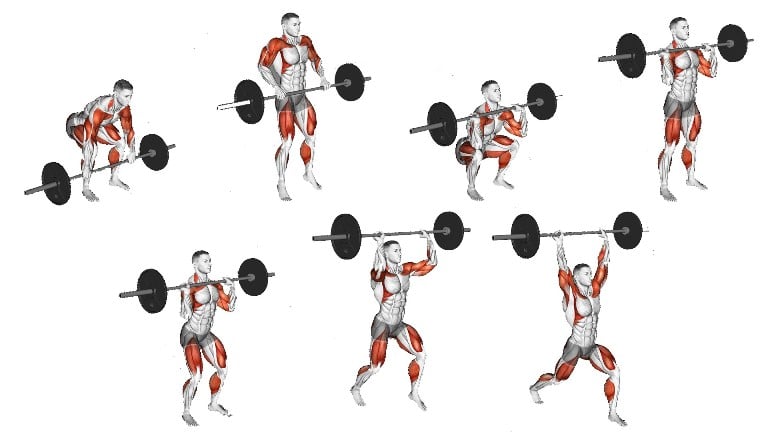
15. Pendlay Row
The Pendlay row strengthens your muscles and adds muscle mass to your lats, traps, and rear delt. It was named after legendary powerlifting coach Glenn Pendlay.
Unlike a traditional barbell row, the Pendlay row begins with the barbell resting on the floor on each rep. This allows you to maintain tension in the lats, lift heavier weights, and achieve a greater range of motion. It’s like a mix between a barbell row and a deadlift.
While it may appear simple at first glance, mastering the Pendlay Row unlocks a potent weapon for building a thick, powerful back.

16. Rack Pull
The rack pull is an exercise that can boost your pulling power and build up your back. It targets the posterior chain, including the glutes, hamstrings, lower back and upper back.
The exercise involves lowering the barbell from about knee-high, which reduces the range of motion compared to a standard deadlift.
It allows you to lift heavier weights, which can lead to impressive strength gains.
This exercise is beneficial for developing muscle hypertrophy, fundamental pulling strength, and grip strength.
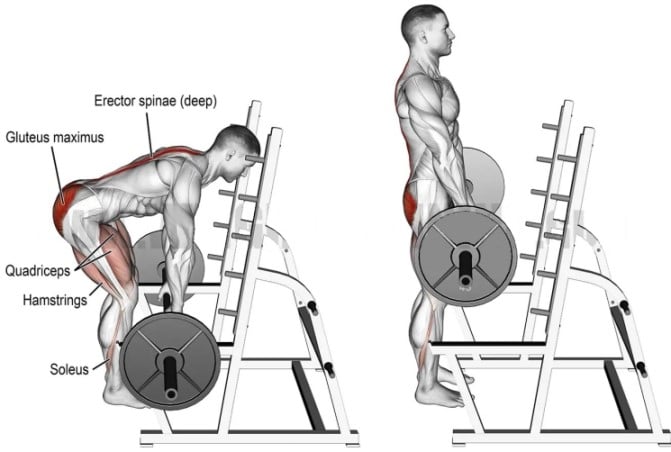
17. Romanian Deadlift
The Romanian deadlift, commonly called the RDL, is a highly effective technique for constructing a robust and stable core, back, and hamstrings.
Unlike a regular deadlift, the Romanian deadlift isolates the hinge pattern since the barbell doesn’t touch the floor during reps.
This allows you to overload the hamstrings and develop greater mobility through the hips and thoracic spine.
- Stand with your feet shoulder-width apart and the bar directly over your midfoot.
- Keep your back flat and hinge at your hips until your torso is nearly parallel to the floor.

18. Sumo Deadlift
The sumo deadlift is a variation of the deadlift that involves a wide stance with the toes pointed outwards. This exercise targets the glutes, hamstrings, and lower back muscles.
Compared to a conventional deadlift, the sumo variation reduces the range of motion while requiring a greater hip and glute contribution to complete the lift.
This means big strength gains for your squats and greater quad sweep.

19. Barbell High Pull
The Barbell High Pull is an explosive and multijoint workout focusing on the upper body, including the arms, upper back, and traps. It’s a good way to make yourself more athletically strong.
- Stand with your feet shoulder-width apart and hold a barbell.
- From this position, explosively extend hips, knees, and ankles, pulling the barbell towards your chin.
- Raise the bar to chest or shoulder height, no higher.
- Carefully lower the bar back to the starting stance.
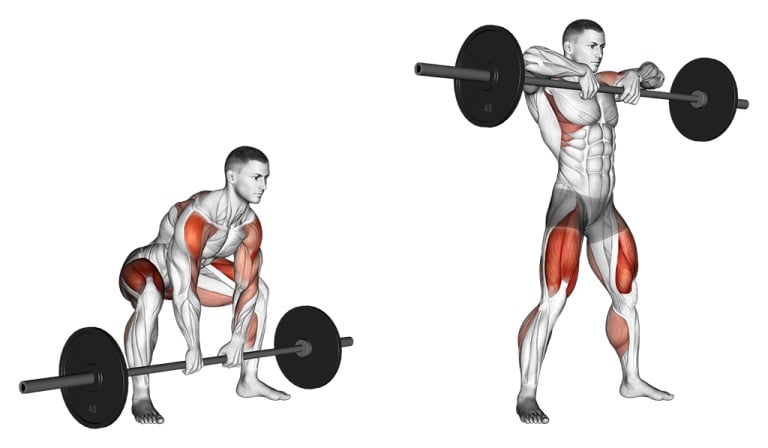
20. Snatch Grip Deadlift
The snatch grip deadlift is an advanced variation of the traditional deadlift, with a wider grip on the barbell. The wider grip of the snatch grip deadlift works more of the upper back than the lower back.
The exercise is also known for its ability to improve grip strength and teach patience off the floor.
It is recommended to master the form for a traditional deadlift before attempting the snatch grip deadlift.
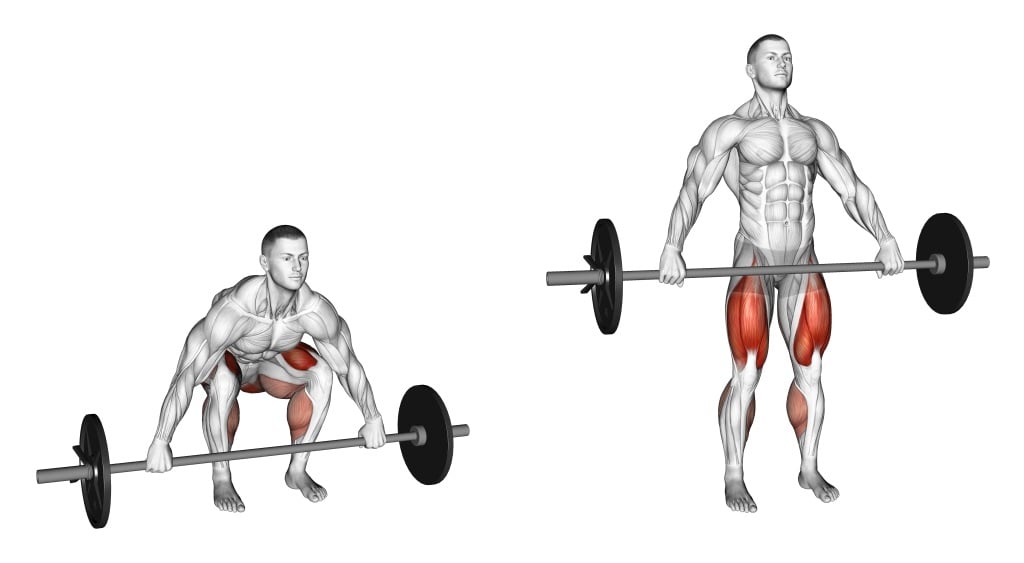
Dumbbell Back Exercises Names
Dumbbells are an effective and dynamic way to target your back muscles. They focus on strength, endurance, and symmetry.
The good thing about using dumbbells for back exercises is that they can work on each side of the back separately, which helps to fix muscle imbalances.
This list has over 20 exercises that are specifically designed to build back muscles. You will find brief descriptions and illustrations for each exercise.
1. One-Arm Dumbbell Row
If you’re looking for straightforward dumbbell back exercises to add to your routine, the One-arm dumbbell row is a great staple exercise to get you started.
It is an excellent full-range exercise to build the lat muscles. This helps to work on each side independently, thereby providing better muscle isolation and a longer range of motion.
It’s an excellent alternative to barbell rows. This exercise is done with a heavy dumbbell with your body supported by a bench.
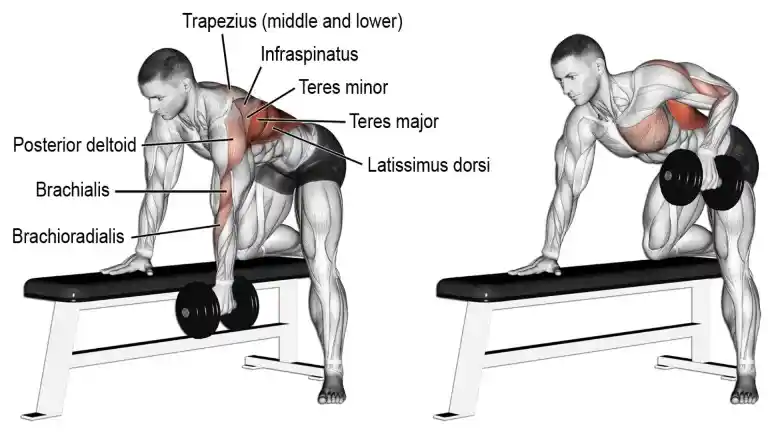
2. Dumbbell Deadlift
The deadlift is the King of all exercises, and It is a powerful exercise designed to build an overall physique that uses more muscles than any other exercise.
The dumbbell deadlift is the best exercise for posterior chain muscle strengthening, which includes the back, erector spine, glutes, and hamstrings.
You can do the deadlift with either a barbell or a set of dumbbells. One of the biggest advantages of using dumbbells for deadlifts is that you can work with a wider range of motion than with barbell deadlifts.

3. Dumbbell Shrug
The dumbbell shrug exercise is another great exercise for your dumbbell back workout, it is one of the best exercises to build bigger, stronger trapezius, upper back, and neck muscles.
This exercise can make your traps bigger, which is helpful when doing back poses. Being a stubborn muscle group for many, traps can be trained with a fairly high frequency during the week.

4. Dumbbell Upright Row
The Dumbbell Upright Row exercise is one of the best dumbbell exercises for the back that you can do during your upper body workout.
It is a compound exercise that targets your deltoids (shoulders) and traps (upper back) and biceps. It also activates the forearms for stabilization and support.
Using dumbbells in the upright row can help to increase unilateral muscle development and address any asymmetries and movement imbalances as well.

5. Dumbbell Bent Over Row
If you are looking to strengthen the upper back with a dumbbell only workout and want to add massive muscle to the upper back region, then bent over dumbbell back rows is one of the best options.
It involves pulling the dumbbells towards your torso while maintaining a bent-over position, engaging the back muscles to perform the movement.
- Pulling the dumbbell up higher toward the chest targets the upper latissimus and trapezius.
- Pulling the dumbbell through a lower trajectory to touch the abdomen targets the lower lats.

6. Incline Dumbbell Row
The incline dumbbell row also known as chest-supported row, is an ideal row variation to get the best form, prevent mid-row rocking, reduce the risk of injury, and isolate the muscles you’re looking to build.
Keep your chest on the bench throughout the movement will eliminate momentum and work the muscles you want.

7. Renegade Row
The renegade row is also known as a plank row, which is almost a variation of the dumbbell row. It is designed to target the upper back. Like a plank, it is designed to target the core.
The renegade row is a multitasking exercise that tones your back and works your core, while also testing your balance and stability.
It’s the ultimate functional strength-training move that will give you a massive back.

8. Dumbbell Farmers Walk
The farmer’s walk exercise, also called the farmer’s carry, is a strength and conditioning exercise.
During a farmer’s carry workout, you hold a heavy load in each hand while walking for a designated distance.
Farmer’s walk with dumbbells might be one of the best classic exercises and a move that mans’s been doing since the beginning of time.
It allows you to accomplish a tremendous amount in a single exercise. This dumbbell workout is a must-have addition to your back workout regimen to build a strong and impressive back.

9. Side-Lying Rear Fly
When doing a back workout with a dumbbell, there are plenty of single-arm exercises you can add to correct potential imbalances. The side-lying rear delt fly is an upper back exercise used to target the rear delts and rhomboids.
It is a great unilateral exercise used to target a smaller and often lagging muscle group. Instead of lying on the floor, you can lie on a bench.

10. Bent Over Rear Delt Fly
The dumbbell rear delt fly is a simple yet effective exercise that increases deltoid muscle definition and strength.
The rear delt dumbbell fly targets your upper back muscles and shoulder muscles, particularly the rear deltoids.
For the rear delt dumbbell fly, you should stand with a slight knee bend and feet shoulder-width apart, and hold a dumbbell in each hand.
Then bend forward at the hips and keep your back straight, like a bent-over row position. From there, you lift the dumbbells out to the sides in a wide arc while maintaining a slight elbow bend.

11. Dumbbell Pullover
The dumbbell pullover is a classic strength training exercise that primarily targets the muscles of the upper body, including the chest and the lats.
It’s well-known for its unique way of moving and its ability to stretch and make these muscles stronger.

12. Dumbbell Seal Row
The Dumbbell Seal Row is an innovative back exercise that stands out for its ability to isolate and strengthen the muscles of the upper back with minimal stress on the lower back.
The prone position prevents you from using momentum, so the back muscles do most of the work.
This leads to better isolation and activation of the targeted muscles, including the lats, rhomboids, and traps.
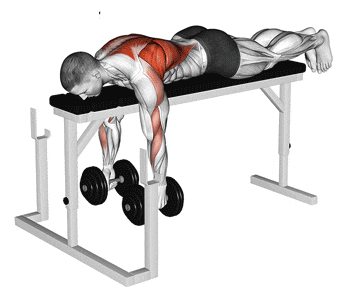
13. Dumbbell Good Mornings
If you’re looking for a new way to work your lower back, try the Dumbbell Good Morning exercise.
It primarily targets the muscles in your lower back, specifically the erector spinae, and also works your hamstrings and glutes.
If you are new to good mornings, it is a good idea to start with bodyweight or a light weight and gradually increase the weight as you get stronger.
14. Dumbbell Superman
The Dumbbell Superman is a simple, yet effective movement you should incorporate into your low back workout routines.
The Dumbbell Superman exercise focuses on strengthening the erector spinae muscles. The traditional Superman move is modified with dumbbells for additional resistance.
It not only targets the lower back, but it also works the glutes, hamstrings, and shoulder to some extent.

15. Dumbbell Wood Chopper
When it comes to strengthening the lower back, people usually focus on doing exercises like deadlifts and rows. If you are looking for a dynamic movement that engages not only your lower back, but also your core, shoulders, and hips, the Dumbbell wood chop is a great choice.
Your lower back muscles help stabilize your spine and torso during the movement, enhancing lower back strength.
This is great for strengthening the twisting movement pattern of your torso, as well as improving your torso’s ability to resist twisting forces.

16. Dumbbell Glute Bridge
The Dumbbell Glute Bridge is an excellent exercise for targeting not only the glutes but also the lower back, hamstrings, and core.
It is a variation of the standard bodyweight glute bridge. Adding a dumbbell makes the muscles work harder, which strengthens the low back and glutes.
This is a simple exercise that you can do at home or in the gym. All you need is a dumbbell and a flat surface.

17. Dumbbell Swings
The dumbbell swings are a full-body workout that targets the hips, glutes, and lower back, as well as working the shoulders and arms.
This exercise requires you to generate power from your hips in order to swing a dumbbell in an arc-like motion in front of you. It’s an explosive move that combines strength and cardiovascular training.
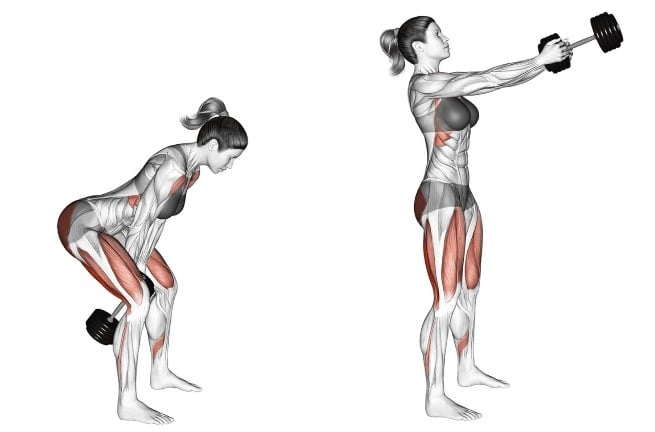
18. Chest-Supported Rear Delt Row
The chest-supported dumbbell row, also called the incline dumbbell row, is an ideal row variation for improving form, preventing mid-row rocking, reducing the risk of injury, and isolating the muscles you’re looking to build.
The muscles used for a dumbbell supported row may change slightly based on your trained range of motion and technique.
To increase the variety of your chest supported dumbbell row, you could try:
- Underhand dumbbell Row
- Neutral grip chest supported dumbbell Row
- Single arm chest supported row
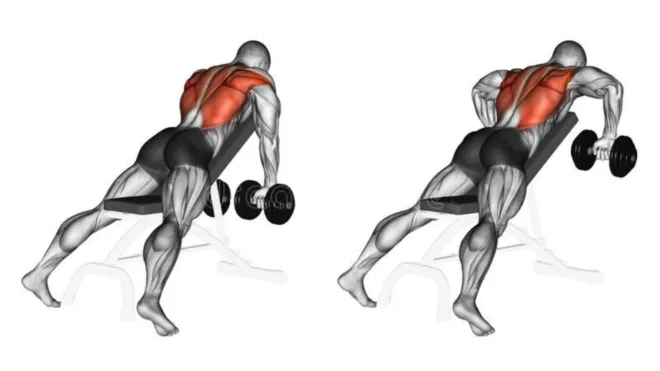
19. Dumbbell Gorilla Row
Don’t do boring rows anymore! Try the dumbbell gorilla row to make your back muscles stronger.
This exercise, inspired by our primate cousins, packs a powerful punch, targeting not only your lats, but also your traps, rhomboids, and core.
- Hold a dumbbell in each hand, and hinge at your hips to lean forward.
- Your arms should hang directly below your shoulders.
- Pull one dumbbell towards your hip.
- Lower the dumbbell back to the starting position and repeat the motion with the other arm.
- The movement should be alternating, resembling the motion of a gorilla.

20. Dumbbell Romanian Deadlift
The Dumbbell Romanian Deadlift (RDL) is a good exercise for making your back muscles stronger. It works the hamstrings, glutes, and lower back muscles.
Unlike its conventional deadlift cousin, the dumbbell RDL offers unique benefits and flexibility.
The dumbbell variations allow for greater range of motion and can help improve hamstring flexibility.
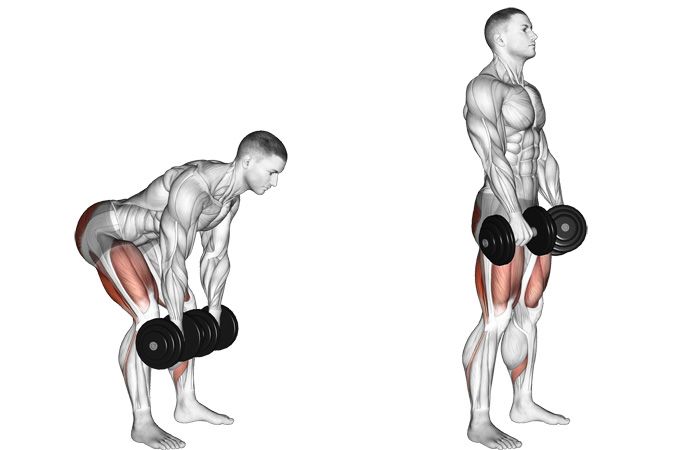
21. Dumbbell I, Y, T, W Raise
These exercises focus on the shoulder and back muscles, mainly the middle and lower part of the trapezius.
They also hit all the rotator cuff muscles, including the infraspinatus, subscapularis, teres minor, and supraspinatus muscles.
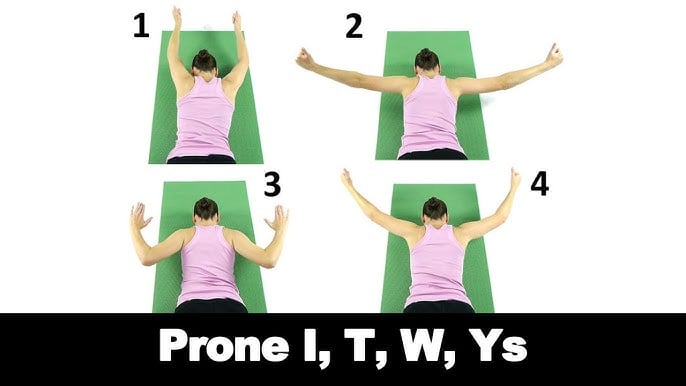
Incline Y dumbbell raises are a great and easy-to-do shoulder stability exercise that targets both the rotator cuff muscles and your mid and lower traps.
Although the Y Raise is commonly performed on an incline bench, it can be modified to suit your needs and performed in various ways: standing, on the floor, flat, or even a Swiss ball.

Name Of Cable Back Exercises
1. Lat Pulldown
Lat pulldowns are a great starting point if you’re looking for a straightforward cable machine exercise to add to your back workout routine.
It is a great cable exercise that fitness trainers widely use to build bigger lats. This isolating exercise focuses on the back muscles without tiring the biceps or triceps.
The lat pulldown can be performed with different variations. With simple adjustments to your grip, posture, or the type of bar you use, you can turn this classic exercise into a multi-faceted tool for back development.
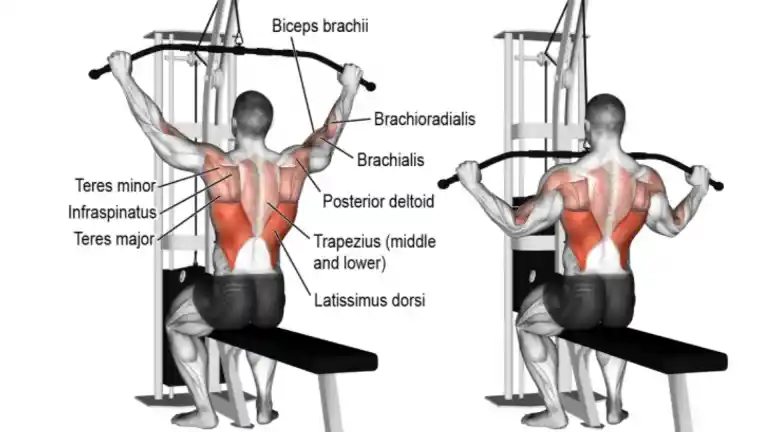
2. One-Arm Lat Pulldown
The one-arm lat pull-down is a unilateral exercise primarily targeting the latissimus dorsi, commonly known as the lats.
It is helpful to perform the exercise unilaterally to identify and address any muscular imbalances between the left and right sides of the back.
I believe it promotes equal development and enhances overall strength and stability.

3. Seated Cable Rows
Seated Cable Rows are an excellent cable exercise to build middle back muscles, and this works on the lower back as well.
This back exercise is done on a cable rowing machine with separate handles and grip position change, the muscle worked involvement.
- Pronated (overhand) grip tends to target the upper and middle trapezius.
- Neutral (thumbs up) grip hits the middle and lower trapezius.
- Supinated (underhand) grip switches the focus to the latissimus dorsi.

4. Wide Grip Seated Row
The seated row is normally done with a narrow grip. But if you’d like to focus on the wider back, you can use a wide grip.
Wide-grip rows can make your back thicker because most of the work is done by the muscles in your upper back.
It is an effective back exercise that targets multiple muscles, including the latissimus dorsi, rhomboids, and trapezius.
To do it correctly, be sure the movement is slow and fluid – no jerking or raising yourself up to push down with your body weight.

5. Straight Arm Lat Pulldown
The straight arm lat pull down is one of the best cable exercises to strengthen your lats (back). This isolation exercise can also help to improve your posture and build a bigger back.
A variation of the traditional lat pulldown but performed with straight arms puts a unique emphasis on the lats.
The exercise will primarily target the lats, but you will also notice a fair number of biceps activation.

6. V Bar Lat Pulldown
During this exercise, a V-shaped bar is attached to a lat pulldown machine, while maintaining a neutral grip and seated position.
The V grip lat pulldown is a variation of the lat pulldown and an exercise used to build the muscles of the back.
It will primarily target the back, you will also notice a fair amount of bicep and middle back activation.
The back is a muscle group that requires a fair amount of variation. So, experiment with several angles and hand positions to maximize your back muscle growth.
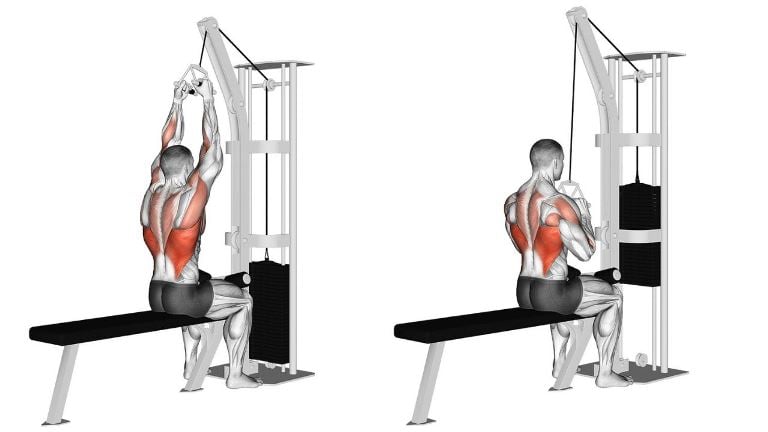
7. Incline Straight Arm Pulldown
It’s highly recommended to include the incline straight-arm pull-down in your cable back workout routine for maximum growth and strength development.
It is a very effective cable exercise for building muscle and strength in the back.

8. Cable Twisting Standing Row
This exercise uses a lot of muscles because you have to turn your waist a little bit. Due to this being a unilateral cable exercise, you will need to engage your core throughout the movement.
You can use this same exercise with different hand placements to target upper or lower back muscles.
Besides being a great cable back exercise, this movement also works your hips, glutes and other lower body muscles.

9. Seated One Arm Cable Row
When doing a back workout with a cable machine, there are plenty of single-arm exercises you can add to correct potential imbalances.
It is a version of the cable row movement that trains the muscles of the upper back one side at a time.
It works well in a variety of rep ranges, but is most popular in muscle-building workouts or as an accessory movement for strength workouts.

10. Double Cable Neutral-Grip Lat Pulldown
The two-arm cable exercise is a brilliant exercise with which you can build your back and arm muscles and develop upper-body strength.
The neutral grip lat pull down promotes the full range of motion of the lats.
Concentrate on squeezing your back muscles at the bottom of the movement.

11. Straight Arm Rope Pulldown
One of my favorite cable back exercises is the straight arm rope pull down.
It is a compound exercise that mainly works the lats, but also works the upper back and shoulders.
It uses a rope attachment to give the beginner a more neutral hand position. This can help relieve joint stress some people may get from using other variations.

12. Bent Over One Arm Cable Pull
If you’re looking for a way to get more creative with your cable back workout, why not try a bent-over one-arm cable pull?
It is an isolation exercise that builds muscle and strength in the latissimus dorsi muscles of the back. It also targets the lower back and core muscles.
But since it’s an isolation exercise, it’s recommended to stick with moderate weights to effectively stimulate the muscle by feeling it contract during each repetition.

13. Cable Upright Row
The cable upright row is a movement that targets many of the large muscles in the upper back and shoulders, which is key for many movements in strength, power, and fitness sports.
Research shows that the upright row is one of the best exercises for building shoulder strength and stability.
Cable machines keep tension on the muscles throughout the entire range of motion, ultimately increasing muscle activation and hypertrophy.
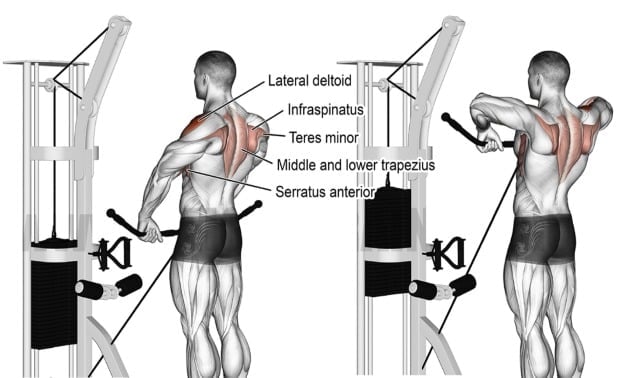
14. Cable Shrug
The cable shrug is a variation of the shoulder shrug and one of the best exercises that are utilized to build the trapezius muscle of the upper back.
It’s one of the best cable exercises for isolating the traps and offers versatility to further improve development.

15. Cable Pullovers
The lying cable pullover is a great alternative to the barbell pullover or dumbbell pullover.
It is the best exercise to build a strong rib cage and build serratus anterior muscle to build a complete chest and back.
Pullover work directly on the serratus anterior muscle to develop the back.

16. Cable High Row
Half kneeling high cable row rope is a tremendous exercise that effectively works many muscles, including the shoulder, back, wing and trapezius muscles.
Using this exercise gives people with shoulder issues an exercise to get the benefits of rows.
In addition, face pull is one of the most effective corrective exercises that help compensate for poor posture and shoulder dysfunction.

17. Reverse Cable Crossover
The reverse cable crossover exercise is another great option that will help you target the back and grow your back.
Your arms should move directly back (and downward slightly) almost parallel to the floor to target the rear deltoid, rhomboids, trap.
Crossing your hands over one another (uncrossing the cables) at the start position increases the range of motion.
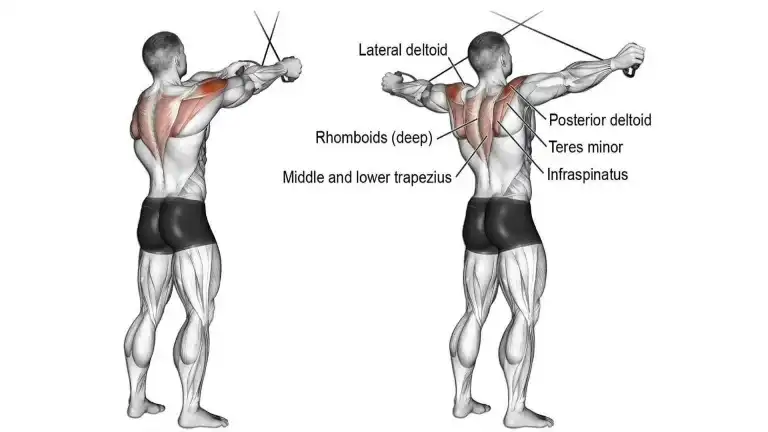
18. Face Pull
Ever seen those guys with awesome backs in the gym? It is likely that they do face pulls. This easy-looking exercise might not look impressive, but it is a great way to build a strong, sculpted back and healthy shoulders.
It primarily targets the rear deltoid and to a lesser degree also targets the biceps, triceps, and traps.

19. Low Cable Row
The low cable row is an upper body exercise that primarily targets the muscles of the middle and upper back, including the latissimus dorsi, rhomboids, trapezius, and rear deltoids. Additionally, it works on the arms and shoulders.
It is done using a cable machine with an adjustable pulley that is set at a lower position.
The exercise involves pulling the cable towards your body while keeping a straight back and engaging your core muscles.

20. Cable Deadlift
The cable deadlift exercise is the best variation of the classic barbell deadlift. This is one of the best cable exercises for the lower back (posterior chain).
The deadlift exercise can be performed using a barbell, a pair of dumbbells and a cable.
One of the biggest benefits of using cable for deadlifts is that it offers a smooth, controlled motion and gives your muscles almost uninterrupted time under tension, and massive pump — each of which can help optimize muscle growth.

21. Close Grip Lat Pulldown
The close grip lat pulldown is an exercise that builds width through the upper and lower lats. This grip helps you focus on the latissimus dorsi muscles by taking your arms out of the movement.
Close grip pulldowns use your elbows instead of your hands to do the exercise. This helps your mind and muscles work together with your lats and reduces stress on your shoulders and biceps muscles.

22. Reverse Grip Lat Pulldown
The Reverse Grip Lat Pulldown, is performed with an underhand grip (palms facing towards you). The reverse grip places greater emphasis on the lower lats compared to other variations.
The underhand grip results in higher bicep activation due to the natural biomechanics of the movement.

24. Behind-The-Neck Lat Pulldown
The Behind-the-Neck Lat Pulldown is a variation of the standard Lat Pulldown exercise, where the bar is pulled down behind the head rather than in front of the chest.
Though this variation can offer some unique benefits, it’s important to note that it may not be suitable for everyone due to the range of motion it demands from the shoulder joint.
This variation places a different emphasis on the upper portion of the lats compared to the standard pulldown.
(Note: This variation is not recommended for people with shoulder issues.)

25. Cable Machine Y Raise
If you’re looking for a way to get more creative with your cable workout, why not try cable Y-raise?
It is a fantastic exercise for the whole shoulder (deltoid) that activates all deltoid fibers: anterior, lateral, and posterior, but it mainly targets the lateral shoulder.
This exercise combines horizontal shoulder abduction with external shoulder rotation. It is strengthening the external shoulder rotators and the internal shoulder rotators.

26. Bent Over Cable Lateral Raise
A bent over cable raise is an excellent exercise to train and isolate the rear deltoid muscle.
There are, however, many bent-over cable lateral raise variations that you can try out that may require different types of bent-over cable lateral raise equipment.
It provides constant stress on the muscle. Unlike dumbbell raises where the resistance varies during the lift, the cable pulley affords a uniform resistance throughout the motion.

27. Cable Rear Delt Row
When you do the cable rear delt row, ensure that your elbows are not dropping.
If your elbows drop, it can cause your latissimus dorsi muscles to engage more, which can turn the exercise into more of a standard wide-grip cable row.
Since you’re working your rear deltoid with the cable delt row and not your larger latissimus dorsi, use a lighter weight than you would with the wide-grip cable row.

28. Cable Stiff-Leg Deadlift
If you’re looking for a straightforward cable lower back workout to build mass and strength, then cable stiff leg deadlift, is a great staple exercise to get you started.
The cable stiff-leg deadlift for hamstrings requires a lighter weight than that used during traditional powerlifting for strengthening the lower back.

GYM Machine Back Exercises With Names
Machines provide stabilized forms of resistance to isolate the back muscles through fixed planes of motion. This allows for heavier lifting with less risk of injury.
This list will explain over 10 popular machine back exercises paired with names, descriptions, and illustrations.
You’ll learn how to perform the seated cable row, lat pulldown machine, low row machine, and more with proper form to maximize size and definition gains.
1. Chest Supported Row
The Chest Supported Machine Row is a specialized gym equipment designed to isolate your back muscles while providing support to your chest and torso.
This machine is an excellent option for those who have lower back issues or simply want to focus exclusively on their upper back muscles, since it minimizes the strain on your lower back.
The equipment usually consists of a padded chest support, a seat, and handlebars or grips connected to a weight stack or plates. You will typically be able to use an underhand grip, overhand grip, neutral grip, close grip, and wide grip.

2. Landmine Row
The Landmine Row is a unique and versatile strength training exercise that utilizes a barbell anchored into a landmine attachment or securely placed in a corner.
The angled position of the barbell gives you a different strength curve than traditional rows, which adds variety to your back workout and targets your muscles in a new way.

3. Pec Deck Machine (Reverse Fly)
The Pec Deck Machine is traditionally used for chest exercises, but can be adapted for a Reverse Fly to target your upper back muscles.
For the Reverse Fly, you’ll be using the machine in a way that’s opposite to the conventional pec deck fly. It is a simple yet effective exercise that increases deltoid muscle definition and strength.
It targets your upper back muscles and shoulder muscles, particularly the rear deltoids, (backside of your shoulders), Traps and rhomboid.

4. Iso-Lateral Lat Pulldown
The Iso-Lateral Lat Pulldown is a modified version of the traditional lat pulldown, typically performed on a machine that permits independent arm movement.
Unlike its traditional counterpart, the Iso-Lateral version uses separate weighted arms, allowing you to train each side of your back independently.
This can be a game-changer for correcting imbalances and sculpting a truly impressive physique.

5. Back Extension Machine
The Back Extension Machine is an essential piece of gym equipment specifically designed to target the muscles in your lower back.
The machine typically features a padded surface for your hips and thighs and foot pads to anchor your feet, enabling you to safely perform hyperextension movements for your back.
For beginners and those recovering from an injury, the machine offers a safer alternative to free weights, since it provides a controlled range of motion.
It’s a simple exercise to learn, so you can start using it right away.

6. Assisted Pull-Up Machine
Pull-ups are one of the best bodyweight exercises for building upper body strength, particularly in the back and bicep.
However, they can be challenging for many people, especially those who are new to fitness or who are recovering from an injury. This is where the Assisted Pull-Up Machine comes into play.
This specialized gym equipment has a counterweight system that offsets some of your body weight, making it easier to perform pull-ups or chin-ups.
The machine typically consists of a pull-up bar attached to a weight stack via a pulley system, along with a platform or knee pad to place your knees or feet on.

7. Rowing Machine
The Rowing Machine, often just referred to as a “rower,” is a gym equipment piece designed to simulate the action of rowing a boat. It is an excellent tool for cardiovascular conditioning while also providing substantial muscular engagement across various body parts.
Consisting of a sliding seat, footrests, a handle attached to a chain or rope, and a flywheel for resistance, the rowing machine is as versatile as it is effective.
Rowing machines are an all-in-one solution for burning calories, improving cardiovascular health, or gaining strength.

8. Smith Machine For Back Workout
The Smith Machine is a versatile piece of gym equipment that consists of a barbell fixed within steel rails, allowing for vertical or near-vertical movement. This setup provides an element of safety and control that’s not always present in free-weight exercises.
The Smith Machine’s adjustable safety stops make it a great choice for a variety of workouts, from deadlifts, smith machine upright row to bent over rows.
It’s a one-stop shop for both newbies and seasoned athletes. Let’s explore how you can take advantage of this machine for a robust and varied back workout.
For back workouts on the Smith Machine, the muscles targeted can vary based on the exercises chosen. However, here are some of the most commonly targeted back muscles:
- Smith Machine Bent-Over Rows: Target the latissimus dorsi, rhomboids, and middle trapezius.
- Rack Pulls: Focus on the lower traps, latissimus dorsi, and erector spinae.
- Smith Machine Upright Rows: Target the upper traps and rear deltoids.
- One-Arm Smith Machine Rows: This unilateral exercise targets the latissimus dorsi, helping to correct muscle imbalances.
9. Seated Back Extension
Seated Back Extension is a variation of the classic back extension exercise but performed in a seated position. This exercise uses a machine to help strengthen the muscles in the lower back, also called the lumbar region.
The seated position allows you to isolate your lower back muscles more effectively than some other types of back exercises. It provides a safer and more controlled way to work your lower back without putting undue stress on your spine.
There are several setup variations for the machine, but these differences in the backrest, footrest, leg clamps, or presence of handles for stabilization don’t affect the exercise much.

10. Smith Machine Stiff-Legged Deadlift
If you’re looking for a straightforward lower back workout that you can do with a machine to build back strength, then stiff leg smith deadlift, is a great staple exercise to get you started.
It is a variation of the deadlift and an exercise used primarily to target the muscles of the hamstrings and gluteals.
The stiff-leg deadlift for hamstrings requires a lighter weight than that used during traditional powerlifting for strengthening the lower back and legs.

11. Smith Hip Thrust
The hip thrust is a popular exercise that works the glutes, hamstrings, and lower back muscles to strengthen them.
The Smith machine allows you to load up on big weights and focus all of that loading into the glutes so that they get the best workouts.
This also gives you a good range of motion and the kind of continuous tension that really works the lower back and hip muscles.

12. Chest Supported Row
The chest-supported row is similar to the bent-over row. It is one of the most widely used compound exercises. It involves a few different joints that move across a wide range of motion. Therefore, it works many muscles in the upper body and improves strength and endurance.
As the name implies, it is a type of row where your chest is supported on a bench. By leaning into a bench with your upper torso, you can remove the need for your back to support the movement.

Name Of Bodyweight Back Exercises
Bodyweight training helps build a strong, muscular back through challenging exercises that use your weight as resistance. With calisthenics, good form is important for building the mind-muscle connection that is important for muscle growth.
This glossary will overview popular bodyweight back moves like pull-ups, Superman holds, back extensions, and inverted rows.
Let’s build a stronger back with no equipment required!
1. Pull-Up
The pull-up is an upper-body strength movement that targets your back, chest, shoulders, and arms.
They are often a challenge for beginners and even experienced athletes to perform.
The pull-up increases the strength, thickness, and width of your back, specifically your lats. The lats are what influences back width and form the “V” in the upper back.

2. Chin Ups
A chin-up is an exercise where the palms facing towards the body (overhand or pronated grip) while gripping the bar.This grip targets the biceps more than the back and shoulders.

3. Neutral-Grip Pull-Ups
In neutral-grip pull-ups the hands are positioned with a parallel grip (palms facing each other) on the bar or a parallel bar.
This grip variation puts less stress on the shoulder, and also works on the biceps and forearms.
Neutral grip pull/chin up variation can be useful for those who have shoulder injuries or pain, as it can be less stressful on the shoulder joint.

4. Inverted Row
The inverted row (bodyweight rows) creates a horizontal body position, making it easier to perform. It works the back and shoulder muscles from a different angle and improves upper body strength.
In the gym, most people utilize the Smith machine for this exercise.
You can also do the inverted row at home by lying under a chair and pulling yourself up.

5. Superman
Superman is one of the best back exercises that you can do without equipment. It strengthens your upper and lowers back muscles.
If done regularly, the superman exercise may help alleviate back pain that is related to weak back muscles.
Additionally, it strengthens back muscles. It also works on your glutes and your hamstring muscles.

6. Good Morning
It is known as a good morning because of the movement in the erector spinae which resembles the rise out of bed to stretch.
The erector spinae muscles of the lower back work isometrically to keep the spine in an extended position, while the hamstrings and gluteus maximus work isotonically to perform hip extension.
You should add this bodyweight exercise to your back workout routine to strength the lower back.

7. Hip Bridge
The hip bridge is a good starter move for butt, hamstring, and lower back muscles and the best back exercises at home to manage chronic low back pain.
But when you do glute bridges regularly, you are working your glutes and your lower back muscles.
These muscles are meant to hold your body upright, so they will get stronger when you do this.

8. Flat Bench Hyperextension
The bodyweight flat Bench hyperextension exercise hits the erector spinae muscles to build a strong back.
To make hyperextensions difficult, you can also hold a plate to your chest or behind the head for additional resistance.

9. Bird Dog
The bird dog is an exercise that looks elegant and is also very effective for training the core muscles and back muscles. Other muscles, such as the glutes, are also worked on.
It owes its name to the position which alternates between sitting on hands and knees (dog) and stretching the arms and legs (bird).

10. Hindu Push Up
The Hindu push up is a traditional Indian-style exercise practiced by wrestlers.
Each repetition includes going from a downward dog position to a cobra pose, swooping by holding the head and body close to the ground.
The arms would be straight at the beginning and the end of the exercise. This variety of push ups has existed for centuries among Indian martial artists. It works on core strength, back, shoulders, hips, and triceps.
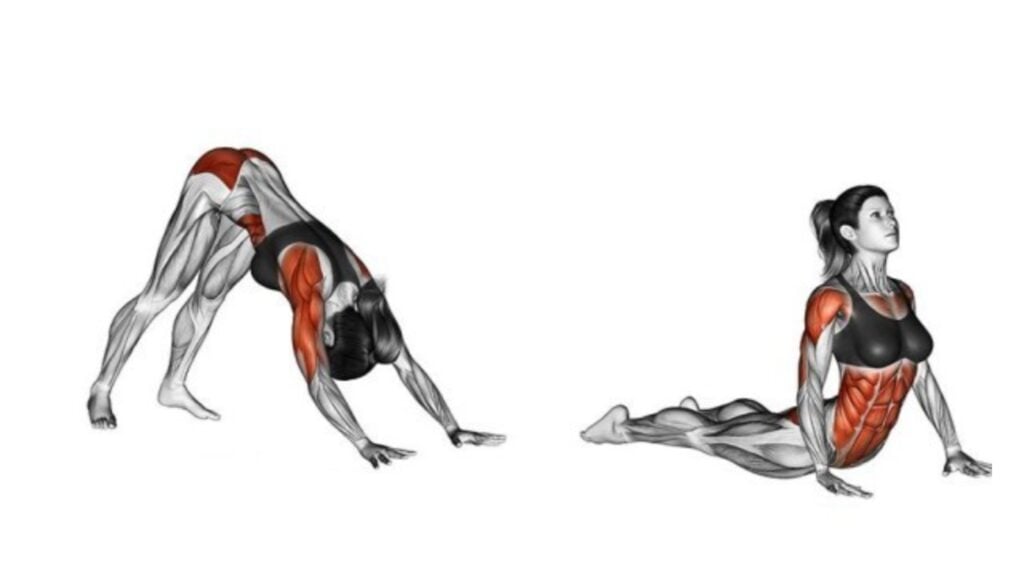
11. Cat Cow
The cat-cow exercise is a spinal mobilization exercise that helps a person “loosen” their spine. It improves movement of your lower back.
The Cat-Cow stretch is a gentle flow between two poses that warms the body and improves spine flexibility. It stretches the back, and neck, and softly stimulates and strengthens the abdominal organs.
This exercise also opens up the chest, encouraging the breath to become slow and deep.
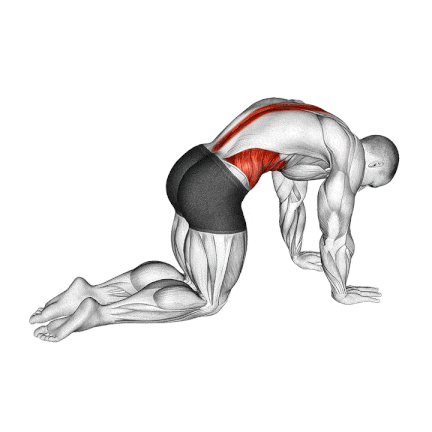
12. High Reverse Plank
The reverse plank exercise is a great bodyweight shoulder exercises for strengthening your core and the key muscles of your posterior chain, namely, your erector spinae, gluteus maximus, and hamstrings.
Beginners should start with learning the regular plank.

13. Bodyweight Shrugs
Bodyweight shrugs are a great way to work your traps without any equipment. It involves lifting and lowering the shoulders in a controlled manner.
Bodyweight shrug is one of the most common trap exercises that target the upper traps.
For an added challenge, try holding a heavy book or water bottle in each hand while you perform the exercise.
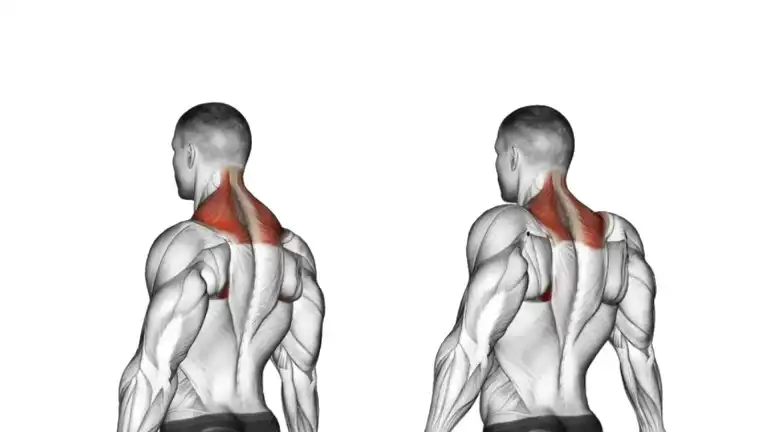
14. Plank
The front plank is one of the most popular core exercises for men. It is a brilliant bodyweight exercise that helps you to develop the strength and stability of your core and back. Your muscles are exercised isometrically.
The exercise is more of a strength-building exercise than a cardio exercise. Engaging a range of muscles can also help to boost your calorie burn.
Variations of Plank for Beginners:
- Knee Plank
- High Plank on Knees
- Side Plank on Knees

15. Commando Pull Ups
Commando pull ups are similar to the close-grip chin-ups, but with a more specific grip.
In this variation, the hands are positioned with a narrow grip, mimicking the grip of a hockey stick, with the palms facing away from the body.
It emphasizes more on the biceps and forearms than back.
It can also be a great way to improve grip strength and endurance.

16. Behind-The-Neck Pull-Ups
Behind-the-neck or rear pull up are variations of your pull-up routine that can be added to prevent boredom and add intensity to your workout routine.
The behind the neck pull up requires a greater range of motion than a standard pull or chin up, which is why it is often more challenging.
Pull yourself up slowly, touching your neck to the bar if possible. Hold this top position for half a second, and then slowly descend back down.

17. Muscle-Up
The muscle-up is an advanced bodyweight exercise that combines a pull-up and a dip into one movement.
It requires significant upper body strength and skill to perform
It’s recommended that beginners start with simpler exercises like pull-ups and dips and gradually work their way up to the muscle-up.

18. Cobra Pose
Cobra Pose (Bhujangasana) is a yoga pose that strengthens the muscles of the back and core while also stretching the chest and lungs.
This reclining pose balances on the tops of the feet and the pelvis, flexing the thoracic spine into extension.
The Cobra Pose works the spinal erectors, glutes, rear delts, traps, and latissimus dorsi muscles for better posture and stability.
The stretch promotes flexibility and blood flow in the torso as well, which aids muscle recovery.
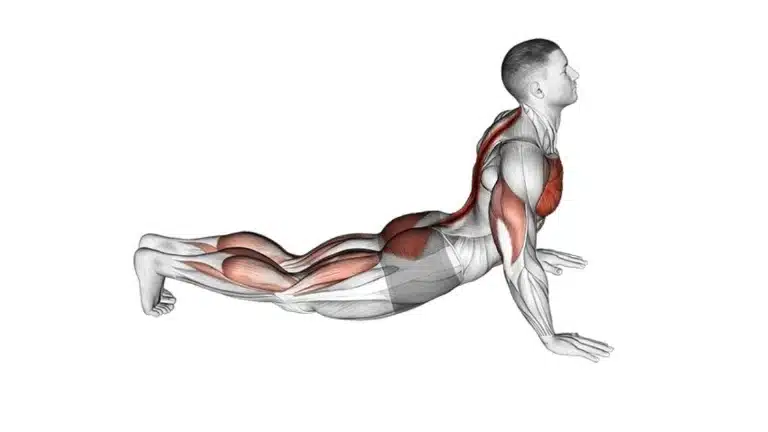
Conclusion
With over 50 back exercises covered, its clear there are plenty of ways to build, strengthen, and challenge the muscles of your back.
The range is extensive, from classic lat pulldowns to unique variations like the dumbbell seal row and machine high row.
With this diverse collection of back exercises that extends beyond the basic routines, your back will experience unparalleled development of strength, size, and definition.
Select your favorites from the list and prepare to witness significant improvements in your back’s muscularity and overall posture.

Manish brings over 10 years of hands-on experience in weight lifting and fat loss to fitness coaching. He specializes in gym-based training and has a lot of knowledge about exercise, lifting technique, biomechanics, and more.
Through “Fit Life Regime,” he generously shares the insights he’s gained over a decade in the field. His goal is to equip others with the knowledge to start their own fitness journey.
